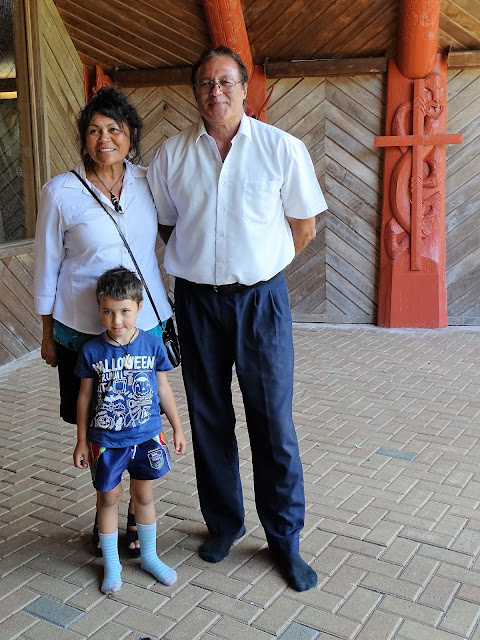The clash of European and various indigenous cultures around the world is pretty much a litany of sadness. While the story of European and Maori interaction is not without complaints on both sides (particularly the Maori), my two far too brief visits to New Zealand have led me to believe that this is (alas) one of the better case examples of how the clash of cultures seems to be playing out in some wonderful ways. This handsome warrior's greeting may as well set the stage for my least planty blog ever...although one never knows. Plants have a way of sneaking in...
 |
| Marae at Keri keri, North Island, New Zealand |
This is a Marae, the traditional Maori "meeting house" that doubles as a sort of living museum of their culture, the equivalent of a church and even a hostel of sorts for clans and families who often sleep here on special occasions. The artwork and stylistics reminded me powerfully of the Pacific Northwestern artwork, and I was not surprised to discover that representatives of the Cowichan tribe had visited recently when they hosted a folk art festival nearby.
We'd seen another Marae--with extraordinary carvings--at the National Museum in Auckland a few days earlier. Our local Maori leader explained that the artwork was all done on a volunteer basis--and necessarily took many years.
And it is perhaps especially significant that when you first arrive in Auckland, and approach passport control one must pass through a stylized Marae-like structure. You are greeted everywhere at the airport (and subsequently as well) with "Ki Ora"--the Universal Maori greeting ("Be Healthy", "Hello", "How are you" are various translations of its meaning)...
A slightly closer look at the Kerikeri Marae artwork. There are apparently thousands of marae in New Zealand (albeit not many this beautiful), and comparable traditional structures were once widespread in much of Polynesia.
Our entire American Horticultural Society group was invited in, following the ritualized protocol of this local clan. I was a humbled when selected "chief" of our visiting delegation, and called upon to speak ceremoniously at one point. Don't worry, you needn't address me as chief any longer!
There is almost something East Asian in the flavor and color of the columns--almost suggesting Chinese dragons to my eye.
This fellow seemed especially athletic, and perhaps annoyed?
Later that day we had a chance to watch a performance of Maori music and dance at Waitangi--the site at the Bay of Islands where the principal treaty outlining the future relationship of Maori and European Settlers was signed on 6 February 1840. There is no doubt in my mind that the Europeans did take liberties and were not as true to the intent of that treaty (leading to much in the way of litigation ever since). But I also think that by and large the English and other European settlers have generally conducted themselves with far greater restraint and decency than European settlers in almost any other region that was inhabited by stone age peoples.
We were permitted to take still pictures, but you will have to imagine the music, which was highly varied depending on the nature of the tune: lyrical love music and stirring battle music.
We even had a stylized duel performed for us!
And a song involving some intricate juggling.
Many of us took the dance troupe up on their suggestion to have pictures taken with them: I was one of the first!
The whole experience helped me get a better sense of the complexity of the Maori/European interaction. There is no question that there has been exploitation and suppression of Maori language and culture in the past, and that much of the land belonging to Maori was unfairly obtained.
But it is also true that the New Zealanders have kept a remarkable number of Maori place names and that Kiwi English is peppered with Maori words. The many gardeners (all of European ancestry) we met all used Maori common names for many of the native New Zealand plants in their gardens.
I heard again and again that everyone wanted Maori language and culture to flourish and everyone seemed to take great pride in the fact that this seems to be in fact happening.
A lovely Sephardic Jew who is on this trip grew up in Istanbul. She informed me that Spain has extended citizenship to her and others whose ancestors were expelled from Spain in 1492. In these dark days when tyrants like Recep Tayyip Erdoğan (and his American equivalents) are still threatening and harassing minorities, I wonder if the time will ever come in Turkey when the first peoples of THAT great country will ever receive their due? Since my paternal ancestors were among those peoples I have a personal stake in the matter! Perhaps one day see Anatolia honor her Kurdish, Armenian and Rum history much as New Zealand now honors its Maori roots? Is this too much to even dream?
It would be wrong for me to end on such a wistful note. Instead, I'd like to end with this picture of our host, his wife and grandson one of whose parents is from the USA. This family exemplifies how many contemporary Maori are firmly rooted in both Maori and European cultures, and comfortable--perhaps even triumphant--in both.


















No comments:
Post a Comment